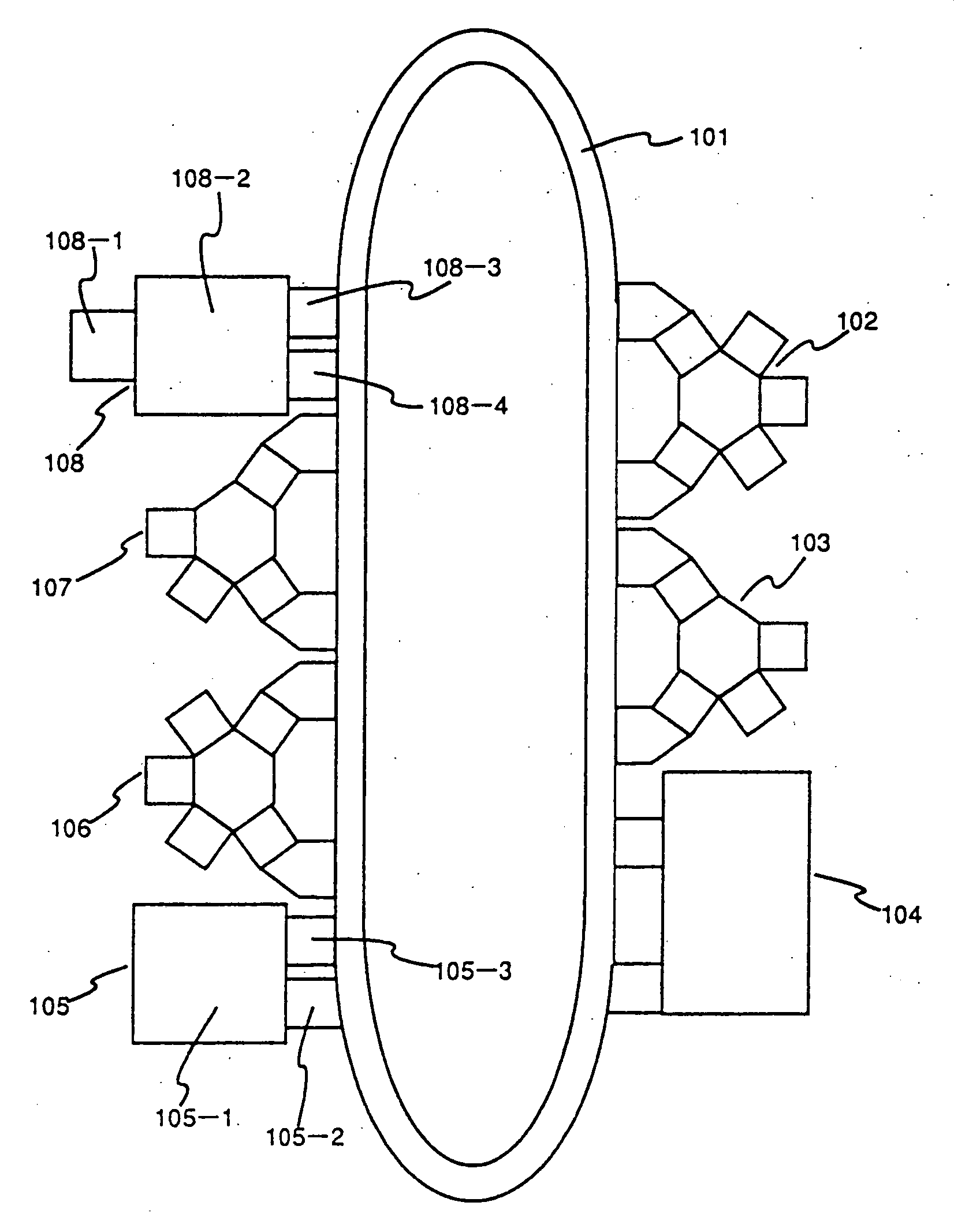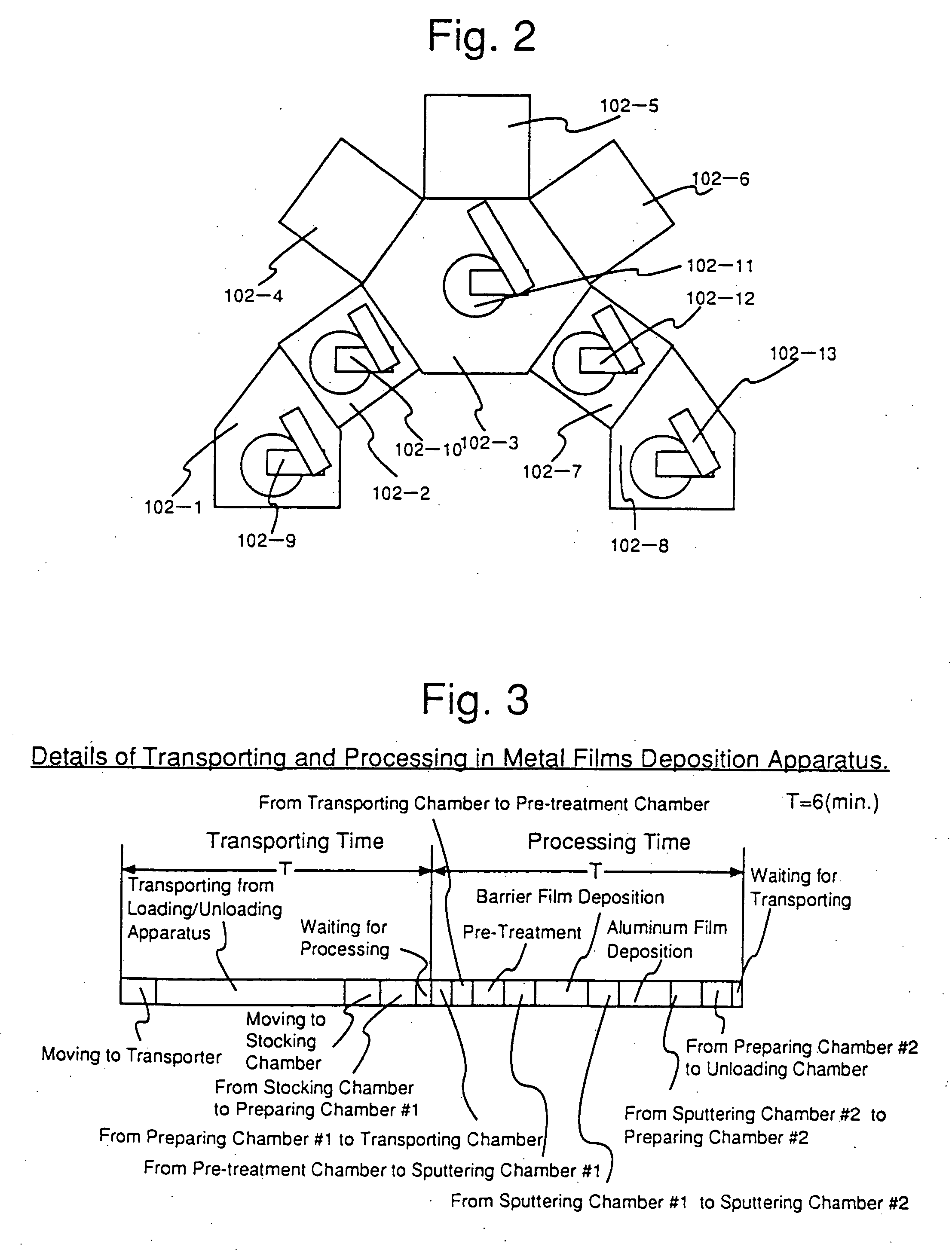Fabrication system and fabrication method
a technology which is applied in the field of fabrication system and fabrication method, can solve the problems of extremely difficult to process these semiconductor wafers under good management, extremely large number of semiconductor wafers processed simultaneously, and very complicated processing, so as to improve the percent non-defective, increase the number of products finished per unit time, and improve the effect of percent non-defectiv
- Summary
- Abstract
- Description
- Claims
- Application Information
AI Technical Summary
Benefits of technology
Problems solved by technology
Method used
Image
Examples
embodiment 1
[0095] This will be described with reference to FIGS. 1 to 12 and Tables 1 and 3. In this embodiment, one layer metal film and a passivation layer are formed on a semiconductor wafer formed with elements and contact-holes.
[0096]FIG. 1 is a view showing the embodiment of the inventive system. A metal film deposition apparatus 102, insulator film deposition apparatus 103, lithography apparatus 104, stocking apparatus 105, metal film dry etching apparatus 106, insulator film dry etching apparatus 107, and wafer loading / unloading mechanism 108 are disposed around a looped inter-apparatus single wafer transporter 101. Six pieces of semiconductor wafers #1 to #6 are continuously processed in the metal film deposition apparatus 102, lithography apparatus 104, metal film dry etching apparatus 106, insulator film deposition apparatus 103, lithography apparatus 104 and insulator film dry etching apparatus 107.
[0097] Six pieces of the semiconductor wafers are unloaded to the fabricating syst...
embodiment 2
[0122] This embodiment will be described with reference to FIGS. 1, 2, 7, 9, 11, 13 and 20. In this embodiment, the present invention is applied to a fabricating system and a fabricating method for fabricating an Si memory LSI, wherein a sequence of metallization processes for a CMOS-LSI having two layer metal films are applied to a wafer.
[0123]FIG. 13 is a view showing a fabricating system according to this embodiment. Lithography apparatuses 201 and 202 are adapted to perform a sequence of lithography processes including resist coating, resist baking, exposure using an infrared ray of mercury as a light source, resist developing and drying. By the provision of a plurality of processing apparatuses capable of applying the same processing, it becomes possible to effectively suppress the disorder of the processing due to a failure of the processing apparatus or the like.
[0124] The construction of each of the processing apparatuses 201 and 202 is the same as that of the lithography ...
embodiment 3
[0139] This embodiment will be described with reference to FIGS. 21 and 22, and Table 5. In this embodiment, the present invention is applied to a fabricating system and a fabricating method for fabricating an Si memory LSI, wherein a sequence of processes for metallization of a CMOS LSI having a two layer metal film is applied to a wafer.
[0140]FIG. 21 is a view showing the fabricating system of this embodiment. Processing apparatuses 301 and 302 are adapted to perform a sequence of lithography processes including resist coating, resist baking, exposure using an i-ray of mercury as a light source, and resist developing. A processing apparatus 303 for dry-etching an interlayer insulator film is a cluster tool capable of dry-etching the SiO2 film or SiN4 film. It is provided with an ashing chamber 303-3 capable of removing the resist, other than two etching chambers 303-1 and 303-2. Each of the etching apparatuses 303-1 and 303-2 can perform the dry etching for the SiO2 film or SiN4 ...
PUM
| Property | Measurement | Unit |
|---|---|---|
| Volume | aaaaa | aaaaa |
| Time | aaaaa | aaaaa |
| Time | aaaaa | aaaaa |
Abstract
Description
Claims
Application Information
 Login to View More
Login to View More - R&D
- Intellectual Property
- Life Sciences
- Materials
- Tech Scout
- Unparalleled Data Quality
- Higher Quality Content
- 60% Fewer Hallucinations
Browse by: Latest US Patents, China's latest patents, Technical Efficacy Thesaurus, Application Domain, Technology Topic, Popular Technical Reports.
© 2025 PatSnap. All rights reserved.Legal|Privacy policy|Modern Slavery Act Transparency Statement|Sitemap|About US| Contact US: help@patsnap.com



